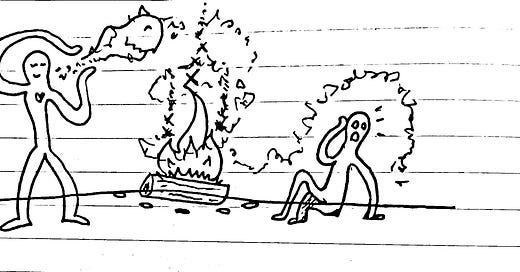Welcome to Art and Survival, a weekly-ish newsletter documenting one theatre-loving boy’s attempt to build a secure life filled with creative acts. You can find out more in the introductory post here.
This week: a reflection on a moving storytelling event and the power of narrative histories.
“Come, and sit with me beside the fire.”
Amber light dances on her wrinkled face. When you look into her pupils, ghosts take shape. They are figures on a scroll, figures on the side of a Greek amphora, figures that shift and move and change and tell their human being story.
“Let the words ignite imagination.”
Her voice is the color of turmeric. Listening to her words, your life dissolves, and the dream she describes becomes your dream. Later, when you return to your body, her story will have laced itself around the ephemeral part of you that you call yourself, where it will hang like a spiderweb from the branches of your memory.
The storytellers – keepers of human being stories – are who we are, because they hold all of our time, all of our places, all of our names. They are the writers whose blood fills up the pages of the books in the library; they are the teachers in the middle school classroom pitching adolescents on essential literature; they are the women walking the streets remembering the ones they used to walk beside. The storytellers’ histories seep into the skin.
The histories that are unknown to you await you.
History has always been difficult for me to experience unless it is narrativized. That’s the power of theatre, of the novel, of film, of paintings, poetry, photography, even some websites– to take true content and give it true function.
True content, according to physicist David Bohm, relies on “observable correspondence.” For example, it would be true in content to say that the sun has risen every day for the past week.
Truth in function involves a “rigorous honest[y] about the accuracy, meaning, and implications of any content,” even if this rigor challenges our sense of security.1
Narrative histories, because they take on a limited, artistic view, and exist within the context of their narrator, give respect to the function of historical content: history is written by an interpreter; no single history is an absolute history.
By surrendering omniscience, narrative histories gain credibility. It also helps that they’re easy to read. When it comes to human survival – and the survival of human stories – narrative histories that can be read or experienced, and then shared, might be one of the most powerful tools we have as a culture for connecting to each other across time, and across death.
Sometimes a single narrative event can serve as a microcosm for the way that narrative histories transcend time. In Stories from the Road, a play that’s a transcript of interviews from a bunch of men, many of whom are HIV+, who have at some point Cycled for the Cause from Boston to NYC, a niche history is narrativized, and a fragmented event – a bike ride – is plugged into the greater whole of a tribe’s experience with a deadly disease. The play, composed by Leland Fowler from interviews conducted with folks who have completed the ride in years past, reflects a lost history, a history of a generation of queer men who struggled to live freely and who had to watch many friends die to a virus.
The play was composed for a one-night-only short reading at the Center in NYC, to raise funds for Cycle for the Cause. Cycle for the Cause is an annual event held to support the work the Center does to help folks with HIV/AIDS. The event was ephemeral, but so deeply powerful – many generations were represented in the room, and so many of us were moved to tears.
I live as part of a generation of queer people who didn’t live through the pandemic of the 1980s, and this reading felt like an act of re-membering to me. Through these interviews, simply and empathetically shared by the actors, the body of a queer history that’s been shattered into fragments is put back together. Younger actors reciting the words of elders invokes a feeling of queer mentorship, of an oral history being passed on by the storytelling event. For the elder generation, back when they first “understood what the virus – how the virus entered the body, and what it was…” to do anything promiscuous meant to be “either on a quasi suicide bent… putting themselves at risk… or not putting themselves at risk and being cautious and afraid. The only freedom came… recklessly.”
In contrast, now, as one interviewee put it:
What you guys [the younger generation] are experiencing... the freedom and the joy... of expressing who you are now... is very much like we were doing back in the ‘70s ... you're not missing anything... you're doing exactly we did in the ‘70s... but... bigger, louder, and freer.
–Thom Kam, interviewed for Stories from the Road, composed by Leland Fowler
To hear so many stories, so much personal history, woven together by a group of oral storytellers is just incredibly moving. And it helps this niche history – the story of what it’s meant to be gay in America over the years – come right to life.
The cycling team that put together this storytelling event is still raising funds toward their goal, and you can make a contribution here. They’ll be riding from September 20th to September 22nd. If you’re curious about these interviews, shoot me a reply here and I can maybe get you in touch with them.
That’s all for this week. Thank you deeply for reading.
Bohm, David. On Creativity. Routledge. 2004. pp. 31.




